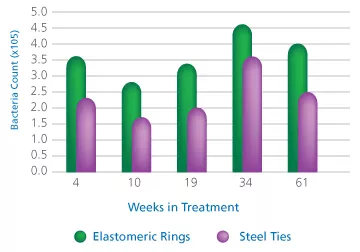Clinical Abstracts and Studies
- Frictional Forces
- Comparison of Maxillary Arch
- Self-Ligating vs. Conventional Brackets
- Damon System vs. Conventional Appliances
- Comparison of Resistance to Sliding
- Self-Ligating Treatment
- Treatment Time
- Self-Ligating in The Year 2000
- Interactive Edgewise Mechanisms
- Force Decay and Deformation
- Ligature Wires and Elastomeric Rings
Ligature Wires and Elastomeric Rings;
Two Methods of Ligation and Their Association with Microbial Colonization of Streptococcus Mutans and Lactobacilli
Forsberg, Brattstrom V, Malmberg E and Nord CE. European Journal of Orthodontics 1991; 13:416-20.
Objective
To compare the number of micro-organisms collected from fixed appliances ligated with elastomeric rings versus those ligated with steel ties.
Methodology
A total of 12 orthodontic patients undergoing treatment with fixed appliances took part in the study. In all patients, elastomeric rings were used for ligation on one side of the midline; steel wires were used on the opposite side. The numbers of streptococcus mutans and lactobacilli were recorded on five occasions in samples of plaque taken from the labial surface of the upper lateral incisors, as well as from samples of saliva.
Results
In the majority of patients, the incisor that was attached to the archwire with an elastomeric ring exhibited 38% more micro-organisms in the plaque than the incisor ligated with steel wire. Following the insertion of fixed appliances, the number of streptococcus mutans and lactobacilli in saliva increased significantly.
Number of Bacteria

Conclusion
In orthodontic patients whose oral hygiene is not optimal, the use of elastomeric rings for ligation cannot be recommended, as they may significantly increase the microbial accumulation on tooth surfaces adjacent to the brackets, leading to a predisposition for the development of dental caries and gingivitis.